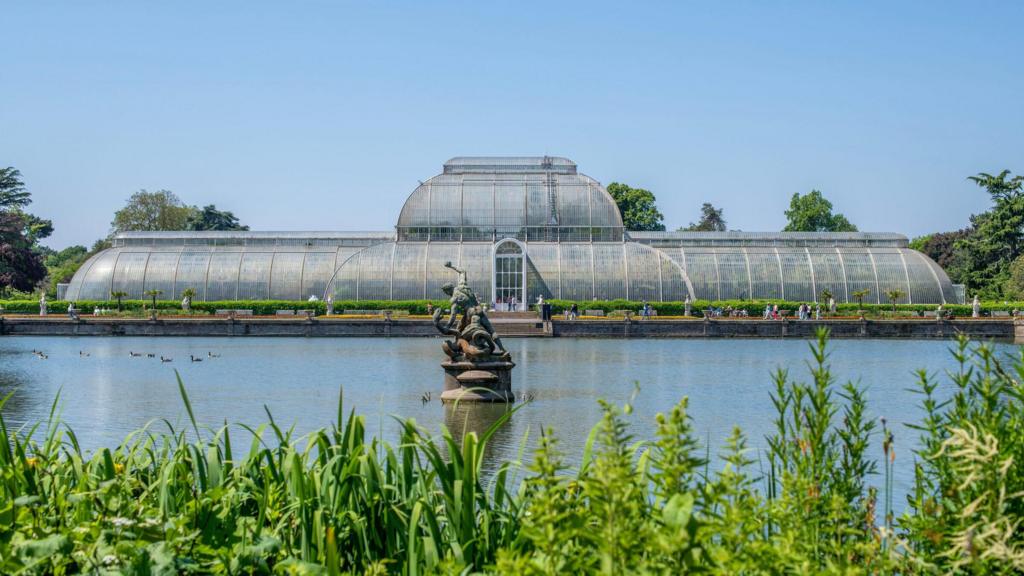A large-scale transformation is underway, involving the relocation of 1,300 plants, the replacement of 16,000 glass panes, and the restoration of hundreds of tonnes of iron.
This marks the ambitious £50 million renovation plan for the globally recognized Palm House, a centerpiece of the Royal Botanic Gardens Kew.
The Palm House, inaugurated in 1848 and home to a tropical rainforest, has been impacted by the hot and humid internal climate.
Kew Gardens intends to utilize the refurbishment – which entails a five-year closure of the glasshouse starting in 2027 – to achieve net-zero emissions for the Palm House.
Planning permission for the project has been formally submitted, and relocation of some of the plants comprising the indoor tropical rainforest has commenced.
“This is probably the plant that I worry about moving the most,” says Thomas Pickering, head of glasshouses.
He stands beside one of Kew’s most prized specimens: Encephalartos altensteinii, a type of cycad.
This potted plant, at 250 years old, predates the Palm House itself. It’s also a substantial specimen, weighing over a tonne and standing approximately 4 meters tall.
“It’s the sheer size of it. It has a huge weight in that root ball, but also this incredibly long stem, which is very old because they’re incredibly slow-growing plants,” says Pickering.
Horticulturists will employ scaffolding, supports, and braces to safeguard the plant during its relocation. Other, more easily movable plants have already been transferred to a temporary greenhouse.
“It’s going to be a long term project,” explains Pickering.
“And over the next two years, it’s going to be a process of selecting which plants we need to containerize (place in pots) and keep, which ones we need to propagate – and also some of the plants will be felled because we won’t be able to move them.”
The Palm House, constructed over 175 years ago, was a marvel of the Victorian era.
Its unprecedented scale required engineers to adapt techniques from the shipbuilding industry to construct the immense structure.
While the structure was last renovated in the 1980s, the ironwork now exhibits significant rust and will be stripped to bare metal, repaired, and repainted.
All of the thousands of single-glazed glass panes will be replaced, with ongoing testing to determine the optimal glass type for maximizing insulation.
Maintaining the Palm House’s temperature at 21°C requires substantial energy. Gas boilers will be replaced with air source and water source heat pumps.
“This is an incredibly challenging building to make net zero,” said Rachel Purdon, head of sustainability at Kew.
“We can do a huge amount with things like sealing the glass and improving the heating systems to massively reduce the carbon footprint and improve the sustainability of the Palm House without impacting the aesthetics.”
The Water Lily House, adjacent to the Palm House, will also undergo renovation. Both will remain open to the public for the next two years before closing for the works.
Kew’s team recognizes the undertaking’s scale and its temporary impact on visitors. However, they assert that the long-term benefits will be worthwhile.
“The really important aspect of this is to try and ensure that the structure can last as long as possible, before we have to do another refurbishment,” says Rachel Purdon.
Sign up for our Future Earth newsletter to keep up with the latest climate and environment stories with the BBC’s Justin Rowlatt. Outside the UK? Sign up to our international newsletter here.
An £50m plan to renovate the world-famous Palm House at Kew Gardens is set to take place.
More than 670 individual butterflies have been recorded at Kew Gardens since April.
Heather Taylor, known as the plant doctor, said the time you water can be critical.
The glasshouses at Birmingham Botanical Gardens are Grade II-listed.
The Planning Inspectorate turns down an appeal to run the heat pumps 24 hours a day, due to noise.

